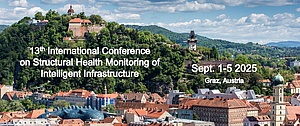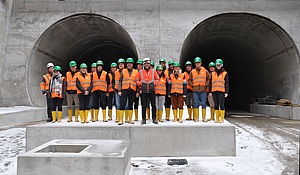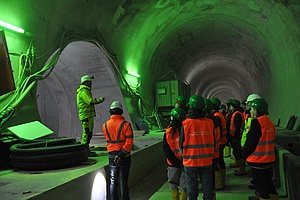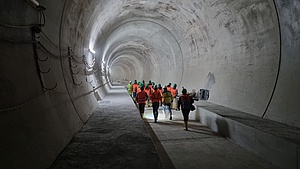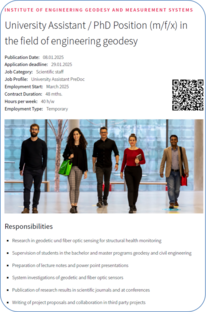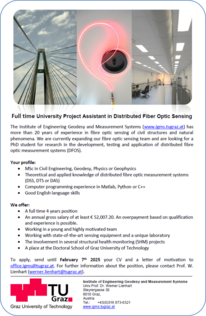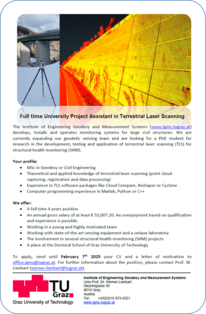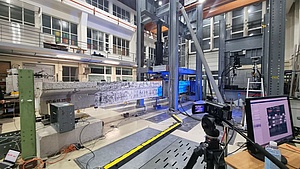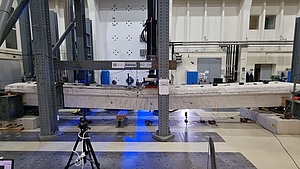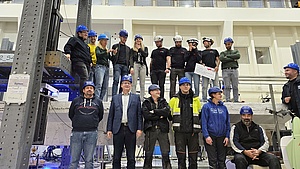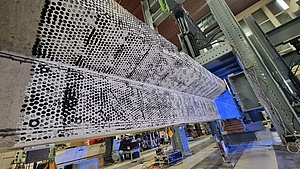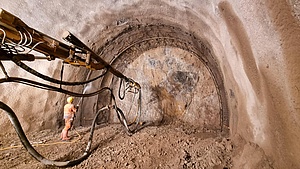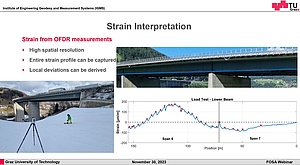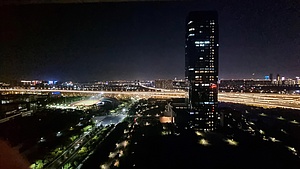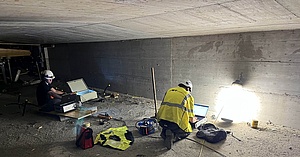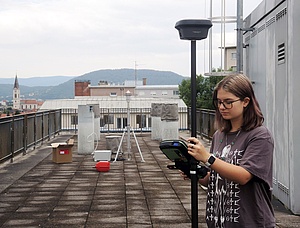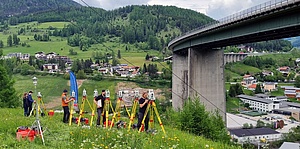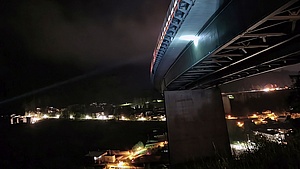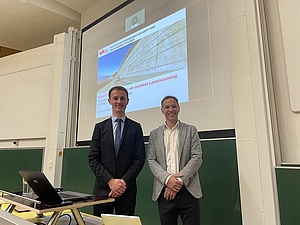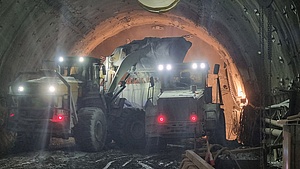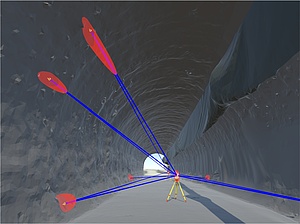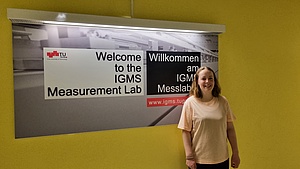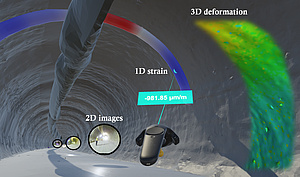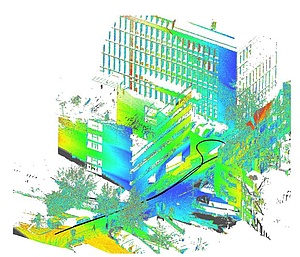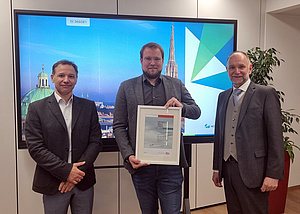17.09.2025
Ingenieurvermessungskurs 2026: Call for Abstracts
Der 21. IVK wird vom 10. bis 13. Februar an der Technische Universität Graz stattfinden. Diese traditionsreiche Veranstaltung wird in abwechselnder Reihenfolge von der Technische Universität Graz, der Technische Universität München und der ETH Zürich organisiert und fokussiert sich auf den Austausch zwischen Praxis und Wissenschaft.
Wir freuen uns auf Ihre Beitragsvorschläge, welche Sie bis zum 31.10.2025 einreichen können. Nutzen Sie auch die Gelegenheit, sich in einem der Tutorien zu den Themen:
- Dynamisches Bauwerksmonitoring mit geodätischen Messverfahren
- Netzanalyse
- Monitoring mit Punktwolken – High-end TLS vs. Low-cost LiDAR
- Digitalisierung am Bau
- Interpretation von interferometrischen Deformationszeitreihen (InSAR)
fortzubilden.
Mehr Informationen erhalten Sie auf der Homepage www.ingenieurvermessungskurs.com
25.08.2025
SHMII-13 conference starts soon
We are looking forward to welcome the international Structural Health Monitoring (SHM) communitiy next week at the SHMII-13 conference in Graz. For more details take a look at the conference website SHMII-13 website.
17.01.2025
Geodesy Student Visit Tunnel Construction Site
The bachelor students of our degree program Geodesy had the chance to visit the surveying and monitoring installations at the construction sites of the Semmering Base Tunnel (SBT). The challenging rock conditions required innovative monitoring approaches and our distributed fiber optic sensing (DFOS) solutions were used in large to monitor the tunnel outer lining, shafts, reinforced earth structures and nearby pipelines as discussed in our open access paper. We want to thank Johannes Fleckl of the Austrian Railway company ÖBB for the insights into the project and Christoph Meyer from Geodata for the details on the tunnel direction control with geodetic gyros.
09.01.2025
3 New PhD Positions at IGMS
We are expanding our team and are offering 3 new PhD Positions:
- University assistant position (including teaching) in engineering geodesy: link to application (EN, DE)
- Project assistant position in distributed fiber optic sensing (DFOS): link to application
- Project assistant position in terrestrial laser scanning (TLS): link to application
All positions are full time. We are looking forward to your application and welcoming you in our team.
12.11.2024
Geodetic and Fiber Optic Measurements of a Bridge Girder
This week we had the chance to perform measurements of a pre-stressed bridge girder which was loaded in several phases until failure. Our team applied point wise measurements (total stations for 3D displacements, IoT sensors for inclination changes and accelerometers) as well as different fiber optic sensing techniques (DSS, DAS) to measure static and dynamic strains. We are looking forward to process our data together with the data captured by the Slovenian National Building and Civil Engineering Institute (ZAG). A special thank you to Maja Kreslin, Andrej Anžlin, Mirko Kosič, Doron Hekič, Petra Triller, Vladimir Požonec and the whole team from ZAG for the opportunity to participate in the tests and their support.
02.10.2024
Announcement of SHMII-13 Conference
We are excited to announce the 13th International Conference on Structural Health Monitoring (SHMII 13) which will be held in Graz, Austria in September 2025. Experience a week full of informative presentations, interesting discussions and exciting excursions. The call for special sessions is currently open and the call for papers will open soon. For more information visit the conference website.
25.01.2024
Structural monitoring in the city center of Austria’s capital Vienna
The construction of the new U2/U5 metro lines requires permanent monitoring of the historic buildings above ground as well as precise staking out of the new underground stations for the fully automated operation of the metro line. We want to thank Wiener Linien and the surveying office VSP for the opportunity to visit the construction sites at Vienna City Hall and Matzleinsdorfer Platz.
19.01.2024
Excursion to Semmering Base Tunnel
Our students had the great opportunity to experience tunnel construction live at the Semmering Base Tunnel. Only about 500 m of length are missing of this challenging 27.3 km long double tube railway tunnel. We want to thank Johannes Fleckl of the Austrian Railway company ÖBB for the insights into the project and Christoph Meyer from Geodata for the details on the tunnel direction control with geodetic gyros.
30.11.2023
Webinar on the Potential of DFOS in Bridge Monitoring
We are happy to announce that our recent webinar on Bridge Monitoring with Distributed Fiber Optic Sensing (DFOS) is now on YouTube at the FOSA YouTube channel. In this webinar, we demonstrate the benefits of different DFOS sensing techniques (HD-DSS, DSS, DTS, DAS) for the monitoring of ageing and new bridges. Furthermore, we discuss the relation between strain and displacement measurements and undershighlight the importance of calibration.
13.11.2023
IGMS Spin-off Company ACI_Monitoring wins Start-up Award
Spin-off company ACI Monitoring GmbH won first place in the category Hightech of the Austrian start up competition Jungunternehmer:innen 2023. The prize was awarded by Martin Kocher, the Austrian Federal Minister of Labour and Economy. The award ceremony organized by GEWINN Wirtschaftsmagazin took place at the headquarter of VERBUND AG in Vienna with representatives of the Austrian Federal Ministry of Climate Action, Environment, Energy, Mobility, Innovation and Technology and the Austrian Federal Ministry of Labour and Economy.
21.10.2023
Keynote Lecture at SHMII-12 Conference
Werner Lienhart gave a keynote talk on Applications of IoT Sensors and Virtual Reality in SHM Systems at the SHMII-12 conference in Hangzhou, China. Standing in front of the Digital Twin of a tunnel projected to the huge video wall almost felt like being in the real tunnel. More applications including videos and papers are available on our project site.
27.09.2023
Winner of 2nd Place at SciPix Award
We congratulate our team that won 2nd place at the TU Graz Scientific Picture and Video (SciPix) competition. The award was presented by the new vice rector of research Andrea Hoeglinger. Thank you to everyone who voted for us. For those who have not seen it yet, take a look at our video on the geodetic and fibre optic monitoring of a highway bridge following this link
18.09.2023
DFOS Measurements at New Highway Bridge
IGMS started together with the project partners AIT and ACI Monitoring the distributed fiber optic sensing (DFOS) measurements at the Aurachbruecke. The new Aurachbruecke is the tallest bridge at the Austrian Highway A1 operated by ASFINAG. The reinforced concrete bridge with 6 spans is going to replace the existing steel concrete composite bridge. Fiber sensing cables have been directly embedded into the concrete and measurements are made at different construction stages and at dedicated excitation experiments with shakers. Finally, the entire new bridge will be shifted from the preliminary pillars to the final pillars as shown in the animation.
08.09.2023
Celebration of Tunnel Breakthrough
The Austrian Federal Railway OeBB celebrated the final breakthrough on the Styrian side of the Semmering Base Tunnel. Only 750 m of the entire tunnel length of 27.3 km are still under construction in the county of Lower Austria. IGMS is proud to be involved in several fiber optic monitoring projects at various locations of this important infrastructure project. Accurate surveying at large tunnel projects is challenging and a geodetic gyro is the only instrument for an independent control of the tunnel direction. To ensure the stability of the gyros used at the Semmering Base Tunnel is checked in regular interval at the test facilities in the IGMS measurement lab.
28.08.2023
Video of Highway Bridge Monitoring
IGMS participated in the TU Graz Science Pics competition with a video of the recent monitoring of a highway bridge. The voting for the competition is now closed. Thanks to everyone who voted for it! We are looking forward to the outcome at the award ceremony on Sept. 17th.
17.07.2023
11.07.2023
Deformation Monitoring with Mobile Mapping Systems
Eight years have passed since the first sketches to a turnkey solution for the integrity assessment of retaining walls with mobile mapping systems. Instead of static installations at a few retaining walls, our solution detects significant changes in inclination and position by driving at up to 100 km/h along the highway. The complete workflow is described in detail in our latest publication in the SHM journal and a summary is given in the current GIM issue.
27.06.2023
Field Trip to Tunnel Construction Site
Right at the end of the summer the bachelor students of geodesy had the chance to visit one of the tunnel construction sites of the high-performance train line Koralmbahn. Thanks a lot to Oebb and the measurement and monitoring experts from Permann & Schmaldienst and ACI-Monitoring for the insights of the cut and cover construction process of the 3.3 km long tunnel section.
01./02.06.2023
Geoday 2023
More than 300 pupils attended the Geoday 2023 and experienced all different aspects of geodesy at 20 interactive stations. IGMS showcased a virtual tour of a stalactite cave, highlighted structural health monitoring and performed a fictional crime scene survey with the school kids.
24.05.2023
Loading Test of Highway Bridge
IGMS successfully completed measurements of a loading test of a steel concrete composite bridge on the Austrian A13 Brenner highway. We want to thank the Highway Agency ASFINAG and the police for the great collaboration and also our colleagues from FH Mainz, TU Darmstadt and ACI-Monitoring for their support. Currently, the data of 7 total stations, 3 laser scanners, several accelerometers, tilt sensors, camera systems, GNSS sensors and static and dynamic fiber optic interrogators are being analyzed. The results will be used to calibrate the numerical model of the bridge.
March 2023
UEFA Qualifying at Football Stadium with IGMS Sensing Technology
The Austrian national football team played against Azerbaijan and Estonia at the new Raiffeisen Arena in the current qualification round for the European football championship. To ensure stable ground foundations for the stadium, pile loading tests were performed during the construction phase and monitored in detail by IGMS with distributed fibre optic sensing (DFOS) techniques which is now commercialized by the TUG Spin off company ACI Monitoring. More information on the application of DFOS in pile testing can be found in the open access article here.
27.01.2023
IGMS showcases bridge monitoring at Ball der Technik
IGMS demonstrates current research in bridge monitoring and virtual reality at Ball der Technik. Ball der Technik has a history of more than 160 years and is one of the most elegant dancing balls in Austria. The importance of condition based maintenance was highlighted in interviews, live demonstrations with fibre optic sensors and immersive virtual reality tours.
14.12.2022
Slaven Kalenjuk receives Karl Rinner Award 2021
Slaven Kalenjuk received the Karl Rinner Award 2021 for his research in Structural Health Monitoring (SHM) of retaining walls with mobile mapping systems. The Karl Rinner Award is given by the Austrian Geodetic Commission for outstanding work of young scientists. View the award ceremony and the scientific presentation at YouTube.
11.11.2022
Students experience tunnel construction live
TU Graz students visit the tunnel construction sites Gloggnitz and Goestritz of the Semmering Base Tunnel. At Goestritz the tunnel tubes can only be accessed via a 285 m deep shaft. In front of the tunnel face students get informed about the challenges of geotechnical monitoring and the importance of geodetic measurements.
31.10.2022
Rigorosum Christoph Monsberger
Dipl.-Ing. Christoph Monsberger successfully defended his PhD Thesis with the title “Distributed Fiber Optic Shape Sensing in Structural and Geotechnical Engineering - Principles & Applications”. This thesis will be available soon at the Shaker Verlag. The examiners Prof. Branko Glisic from the Structural Health Monitoring Lab of Princeton University and Prof. Werner Lienhart from TU Graz congratulate Dr. Monsberger on his doctor title.
17.10.2022
Scanning Expedition to Nepal
IGMS started a joint TU Graz expedition in cooperation with the Institute of Architectural Theory, History of Art and Cultural Studies into the Upper Dolpo region in Nepal’s Himalaya. The fieldwork is part of the ongoing FWF project P 35897: "Buddhist Architecture in the Western Himalayas”. The aim of this interdisciplinary work is to explore significant Buddhist temple sites in this remote area and to document them with modern 3D scanning technology for the very first time.
01.09.2022
Virtual Reality as a Planning Tool for Geodetic Network Measurements
Virtual Reality (VR) has evolved from gaming applications to become a valuable tool for geodetic network planing. Take a look at our recent open access publication in the Journal of Applied Geodesy to see how geodetic monitoring can benefit from VR to identify line of sight obstructions, to investigate prism orientations and to select the right type of instrument in underground scenarios with multiple prisms. Access the paper here
02.08.2022
External Examiner at Johannes Kepler University Linz
Prof. Werner Lienhart acts as external examiner at the PhD defending of Thomas Bergmayr. The PhD thesis “Health monitoring of lightweight structures on the example of a civil aircraft spoiler” investigates innovative SHM measurement methods and machine learning approaches for the integrity assessment of aircraft structures. Mr. Bergmayr developed these methods at the Institute of Structural Lightweight Design of Johannes Kepler University Linz and we congratulate Thomas Bergmayr for achieving the doctoral degree with distinction.
20.07.2022
New Video of Bachelor Program Geodesy at TU Graz
TU Graz released a new video of the Geodesy Bachelor program on the TU Graz YouTube channel. Learn more about our courses and see how you can shape the future as a geodesist.
June 2022
Prof. Fritz Brunner passed away
We have to make the sad announcement that the former Head of the Institute Prof. Fritz Brunner passed away on June 19th. Fritz was a remarkable researcher and university teacher. He introduced fibre optic sensing in the field of engineering geodesy and was a recognized expert in geodetic refraction. We will miss Fritz as a scientist, colleague, mentor, lecturer and friend.
07.06.2022
IGMS Article selected as an "Editor's Choice Article"
The IGMS Article on the "Accuracy Investigation of the Pose Determination of a VR System" has been selected by the Editor-in-Chief of Sensors as an "Editor's Choice Article". Follow this link to see how the HTC Vive Pro system has performed in the IGMS measurement laboratory.
09.05.2022
Research visitor from the Faroer Island
Irena Aarberg from the Land and Navigation Department of the Environment Agency of the Faroer Islands stays at IGMS for a one week research visit. The scientific exchange focuses on fibre optic sensing, specifically on applications and data analysis of Fibre Bragg Gratings (FBGs). We welcome Irena at IGMS and are looking forward to the collaboration.

21.04.2022
talto talk about working at IGMS
The career platform for students, talto, interviewed Slaven Kalenjuk about his job as university assistant at IGMS. Slaven provided insights into day-to-day work, challenges and opportunities of working as a researcher at a university. Follow this link to read the graduate story and to watch the complete talto talk.
17.03.2022
Seamless Integration of Fibre Optic and Geodetic Monitoring Data
An early detection of deformations is crucial to assess the integrity of tunnel linings. We discuss the benefits of a seamless integration of fibre optic and geodetic monitoring data and the interaction with the results in a VR environment in our latest open-access paper published in the Journal of Civil Structural Health Monitoring. Access the paper here
11.02.2022
Open Access Paper on Quality Control and Enhancement of Mobile Laser Scanning Data Published
Mobile Mapping Systems (MMS) are standard data acquisition tools for high detailed maps. If such systems are also used for applications with high accuracy demands like structural health monitoring, quality control and mitigation of systematic effects are crucial. Follow this link to our open-access paper published in Remote Sensing that addresses this challenge and introduces an innovative appraoch to detect and correct high-frequency errors.
20.01.2022
Peter Bauer receives Heinrich Wild Award 2021
Peter Bauer received the Heinrich Wild Award 2021 for his work in using VR in the field of Engineering Geodesy. The award ceremony was part of the HxGN LIVE LEICA TOUR DACH 2022 where more than 1200 participants followed the live stream of Peter's talk on geodetic network planing in VR and the use of VR gear as measurement device.
IGMS - Institute of Engineering Geodesy and Measurement Systems
Steyrergasse 30
8010 Graz, Austria
Phone: +43 (0) 316 873 - 6321
email: office.igms@tugraz.at
Web: www.igms.tugraz.at

